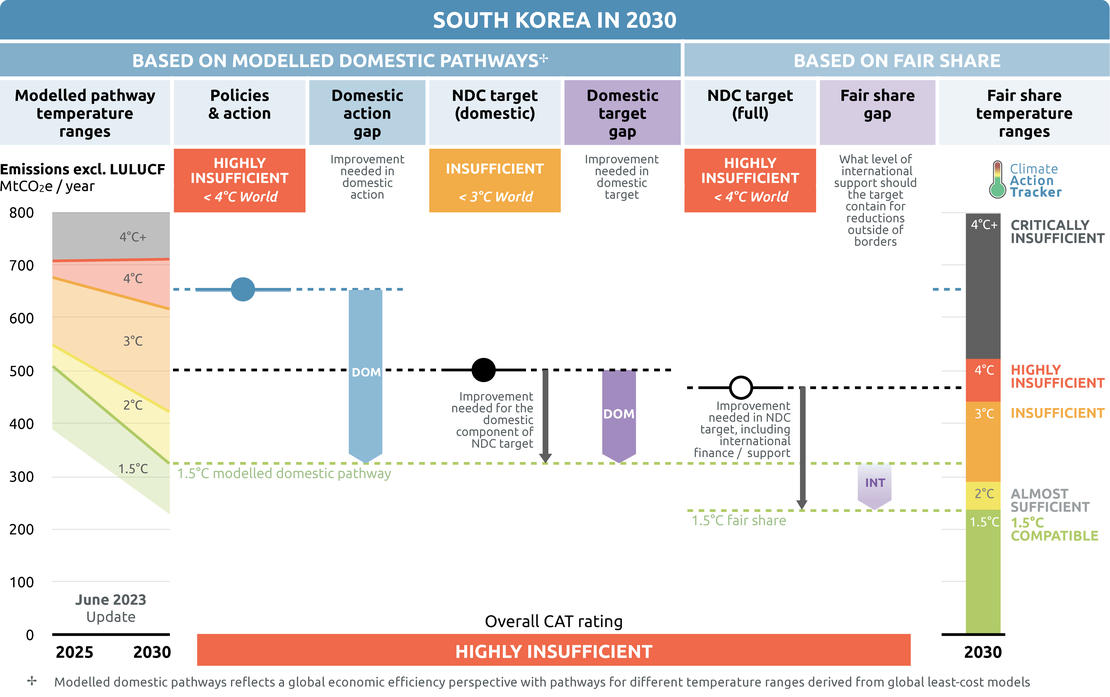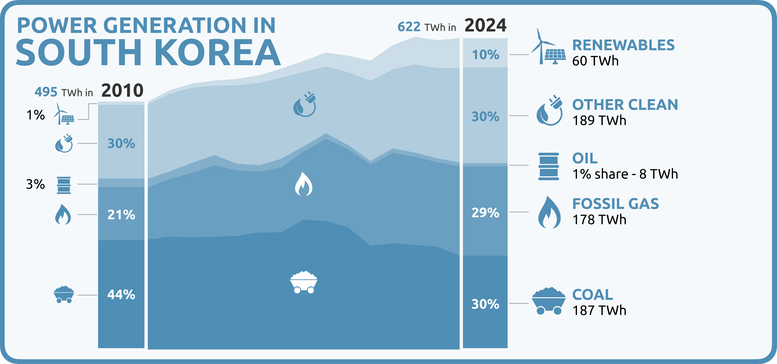Policies & action
We rate South Korea’s policies and action as “Highly insufficient”. The “Highly insufficient” rating indicates that South Korea’s policies and action in 2030 are not at all consistent with the Paris Agreement’s 1.5°C temperature limit. If all countries were to follow South Korea’s approach, warming could reach over 3°C and up to 4°C.
The CAT projected that South Korea’s implemented policies will lead to an emissions level of 650-658 MtCO2e/year in 2030 (1% to 3% relative to 2020 levels, or 116% to 118% above 1990 levels) depending on the eventual impact of the COVID-19 crisis, excluding emissions from land use, land use change and forestry (LULUCF).
After the 2022 elections, the new administration has further pursued the implementation of the carbon neutrality goal: South Korea’s climate neutrality target is enshrined in law through the Framework Act on Carbon Neutrality and Green Growth (Carbon Neutrality Act), which was passed in August 2021, enacted in early 2022 and supported through additional legislation and coordination efforts in October 2022.
To support the carbon neutrality goal, the Act for example introduces a climate impact assessment of major national plans and development projects. Emission reductions targets will now be integrated into national budget planning through the climate-responsive budgeting program. The Act also sets up a climate response fund, which will be used to support the structural transformation of carbon-intense industries.
With the newly passed 10th Basic Electricity Plan, the new government has changed the direction of the electricity sector, favoring nuclear over renewable energy (see more detail in the energy sector section below).
South Korea has joined the Global Methane Pledge and targets reductions of 28.6%, 20.9% and 46.5% from energy, agriculture and waste sectors respectively which in total targeted to reduce 30% methane emissions by 2030 compared to 2018 (Ministry of Foreign Affairs of South Korea, 2021). This means a reduction of about 10 MtCO2e in 2030 below the CAT projections for policies and action.
In 2022, the South Korean government has contributed to several climate finance and investment programmes such as the Carbon neutrality programme (P4G) with USD 4m. The government also pledged to establish the Green New Deal Trust Fund (GNDTF) in GGGI for supporting low and middle-income countries, with a total planned contribution of roughly KRW 6bn – or USD 4.5m. In 2021, the South Korean government committed to supporting the Green Climate Fund in providing a total of USD 30.3 billion for climate projects in partner countries for their climate change response.
Policy overview
Between 1990 and 2020, South Korea’s GHG emissions more than doubled. Emissions steeply increased in the early 1990s, with growth then continuing at a slower pace. The CAT projections for current policies show emission ns decreasing from 2020, leading to an emissions level of 650-658 MtCO2e/year in 2030. In absolute terms, the CAT estimates that South Korea’s updated NDC translates to 501 MtCO2e/year excluding reductions from LULUCF and international credits. To meet the targets set by the new NDC and climate neutrality law, South Korea needs to significantly strengthen its climate policies.
One of the main cross-sectoral policy instruments implemented to date is the Korea Emissions Trading Scheme launched in 2015 (ICAP, 2019). Phase III (2021-2025) of the ETS was announced in September 2020 and increases the scope from 68% to 73.5% of national GHG emissions, covering 685 companies in 69 subsectors, including steel, cement, petrochemicals, refinery, power, buildings, waste, and aviation (Ministry of Environment, 2021).
The ETS system includes both direct and indirect emissions (emissions from electricity use). The allowable share of offsets for an entity’s compliance obligations decreases from 10% to 5%, while the share of auctioning for 41 of the 69 covered sub-sectors will increase from 3% to 10%, in comparison to the previous phase. The remaining sub-sectors receive 100% free allocation, determined by an assessment of carbon leakage.
The increased shared of auctioning, however, remains low compared to the EU ETS, which in Phase IV auctions 57% of allowances (Serre et al., 2015). In 2021, the ETS permit price covered 79.6% of CO2 emissions from energy use. In total, 96.5% of CO2 emissions from energy use in Korea were priced in 2021, unchanged since 2018. Fuel excise taxes, an implicit form of carbon pricing, covered 65.8% of emissions in 2021, unchanged since 2018 (OECD, 2021).
The 2020 Green New Deal commits around USD 31 billion to green remodeling, green energy, and eco-friendly vehicles (Ministry of Economy and Finance, 2020). By 2025 the Green New Deal will target 42.7 GW of renewable power capacity, 1.13 million electric cars, 200,000 hydrogen cars, and the scrapping of 2.2 million old diesel cars. The final deal did not introduce the carbon tax, however, this is mentioned as a planned policy in South Korea’s 2050 carbon neutrality scenarios, published in October 2021 (Republic of Korea, 2021a). According to the Green New Deal, the government will invest KRW 73.4tn or USD 56.6bn (KRW 42.7tn or USD 33 billion from the Treasury). With the aim of strengthening climate action and realising a green economy, investments will focus on green infrastructures, renewable energy, and fostering green industry (IEA, 2021b).
The Hydrogen Roadmap, published in 2019, sets targets for hydrogen in the transportation and energy sectors: 2.9 million hydrogen vehicles by 2040 and 15 GW of power generating capacity from fuel cells (MOTIE, 2019b). South Korea’s current hydrogen demand of 13,000 t/year in 2019 is produced from petrochemical industry by-products. Under the Hydrogen Roadmap, the demand will increase to 5.36 million t/year by 2040; the additional demand in the short-term will be met by LNG and therefore will not lead to significant emissions reductions. South Korea is, however, investigating options for producing green hydrogen in the long-term. The new President Yoon Suk-yeol has stated his support for ambitious hydrogen industry as a priority (Korea Times, 2022).
Sectoral pledges
In Glasgow, a number of sectoral initiatives were launched to accelerate climate action. At most, these initiatives may close the 2030 emissions gap by around 9% - or 2.2 GtCO2e, though assessing what is new and what is already covered by existing NDC targets is challenging.
For methane, signatories agreed to cut emissions in all sectors by 30% globally over the next decade. The coal exit initiative seeks to transition away from unabated coal power by the 2030s or 2040s and to cease building new coal plants.
Signatories of the 100% EVs declaration agreed that 100% of new car and van sales in 2040 should be electric vehicles, 2035 for leading markets. On forests, leaders agreed “to halt and reverse forest loss and land degradation by 2030”. The Beyond Oil & Gas Alliance (BOGA) seeks to facilitate a managed phase out of oil and gas production.
NDCs should be updated to include these sectoral initiatives, if they’re not already covered by existing NDC targets. As with all targets, implementation of the necessary policies and measures is critical to ensuring that these sectoral objectives are actually achieved.
| SOUTH KOREA | Signed? | Included in NDC? | Taking action to achieve? |
|---|---|---|---|
| Methane | Yes | Yes – 2021 update or earlier | Yes |
| Coal exit | Yes | Unclear | Yes |
| Electric vehicles | No | N/A | N/A |
| Forestry | No | N/A | N/A |
| Beyond oil and gas | No | N/A | N/A |
● Methane pledge: South Korea joined the Global Methane Pledge. The government announced specific emissions reduction targets from the agricultural sector, from waste and from energy. South Korea also announced a methane reduction plan that included a national target to reduce emissions from 28MtCO2e in 2018 to 19.7 MtCO2e in 2030, a 30% reduction in line with the Global Methane pledge’s target.
● Coal exit: South Korea signed up to the coal exit pledge at COP26. However, it had not agreed to a date to shift away from coal and pledged to significantly eliminate coal from its energy generation by 2050. South Korea has started its path to decommission coal power plants and stop financing coal plants abroad.
Power sector
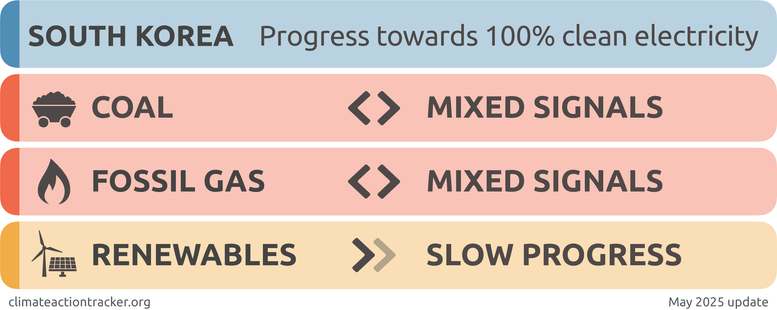
South Korea’s power sector policies and plans are far from being compatible with the Paris Agreement’s 1.5 °C temperature limit, under which coal-fired power must be phased out before 2030 and the role of LNG also needs to decrease. In 2024, coal and nuclear power both accounted for 30% of electricity generation, followed by fossil gas (29%), renewables (10%) and oil (1%) (Ember, 2025).
The two framework policies for the energy supply sector were the Third Energy Master Plan adopted in June 2019 for the period up to 2040 (MOTIE, 2019a) and the Ninth 15-year Basic Plan for Electricity Supply and Demand (Ninth Electricity Plan) adopted in December 2020 for the period up to 2034 (MOTIE, 2020).
In 2022, newly-elected president Yoon Suk-yeol publicly stated his opposition to the renewable energy target 2050. Then, on July 2022, the government released The New Government Energy Policy Direction which replaces the 3rd Energy Master Plan (MOTIE, 2019a), including the nuclear phase-out. It aims to lower the country’s dependence on fossil fuel imports to less than 70% by 2030 and increase nuclear share in the country’s power mix to at least 30% by 2030.
In early 2023, the MOTIE’s General Subcommittee released its “10th Basic Electricity Plan’. To achieve the 10th plan main consideration of “Prioritisation of steady electricity supply for energy security”, South Korea is increasing its nuclear power generation target, and abandoning the nuclear phase-out plan of the previous administration.
Although South Korea signed the Global Coal to Clean Power Transition Statement at COP 26, it will not phase out coal by 2030. South Korea is also increasing its LNG power generation target to produce LNG-based blue hydrogen and ammonia for coal co-firing. The plan is far less ambitious than South Korea’s enhanced NDC in terms of renewable energy power generation. 2030 power generation in South Korea from various policies is shown on the table below (MOTIE, 2022b).
| SOUTH KOREA | Nuclear | Coal | LNG | Renewable | |
|---|---|---|---|---|---|
| 9th Electricity Plan (2020) | Power generation (GW) | 146.4 | 175.1 | 136.6 | 121.7 |
| Share (%) | 25 | 29.9 | 23.3 | 20.8 | |
| NDC (2021) | Power generation (GW) | 146.4 | 133.2 | 119.5 | 185.2 |
| Share (%) | 23.9 | 21.8 | 19.5 | 30.2 | |
| 10th Basic Electricity Plan (2022) | Power generation (GW) | 201.7 | 122.5 | 142.4 | 134.1 |
| Share (%) | 32.8 | 19.7 | 22.9 | 21.6 | |
In 2021, the share of coal-fired power generation decreased further to 35%, from above 40% over the last decade and from 36% in 2020. The use of renewable energy only increased slightly. More notable is an increase in gas-based electricity production which produced 31% of electricity. Nuclear electricity generation decreased slightly, but the new government is prioritising the role of nuclear in the future electricity mix and dropping the previously-agreed nuclear phase-out, instead aiming to increase nuclear production. While the share of renewables in the sector has doubled in the last five years, it remains small at around 6%, considerably lower than the EU, Japan, and the US (see Figure below), and far from the 2030 NDC target of 30.2%.
Coal
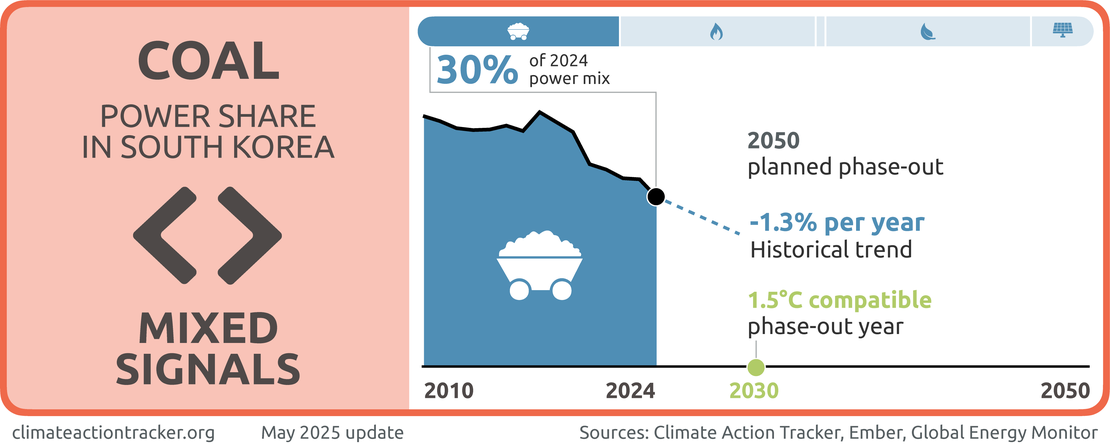
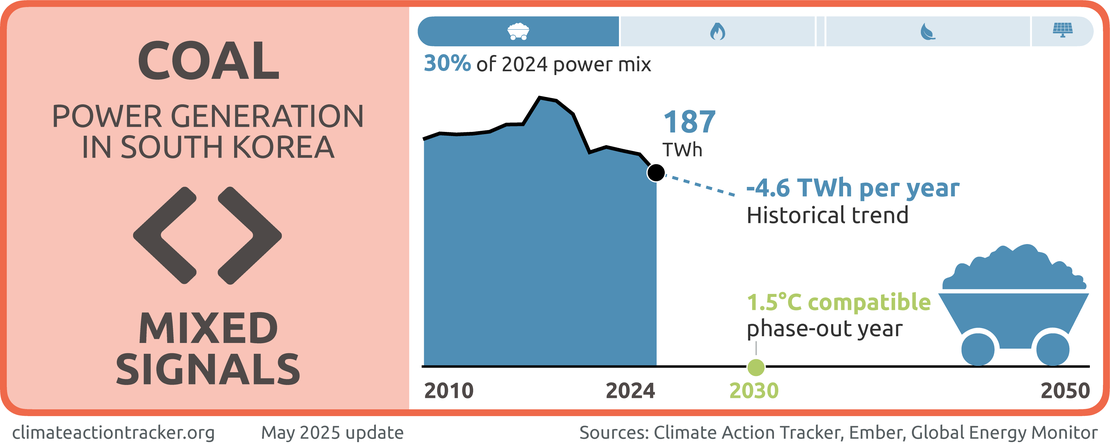
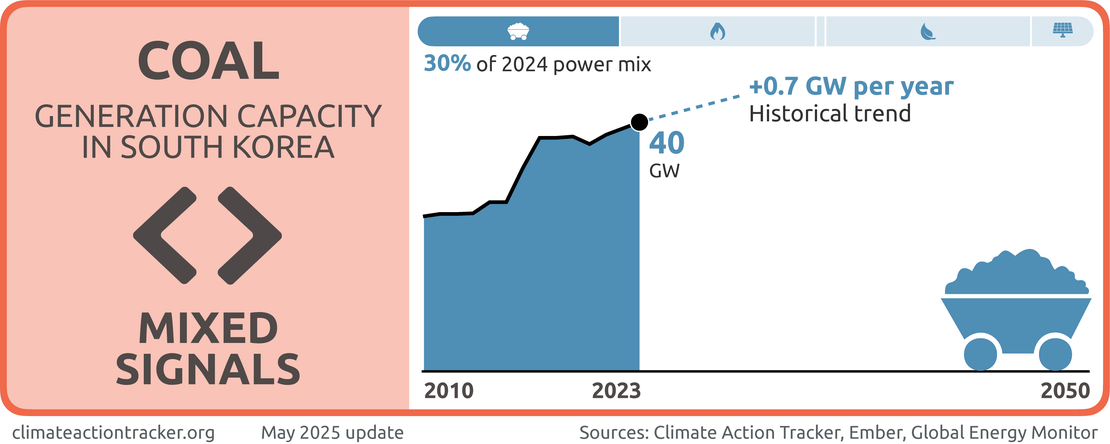

South Korea is sending “Mixed Signals” on coal.
Although the share of coal in the power mix has steadily declined in the last five years, falling from 42% in 2019 to 30% in 2024, South Korea continues to expand its coal capacity. A total of 1.1 GW of coal projects remain in the development pipeline (Ember, 2025; Global Energy Monitor, 2025).
The government has committed to phasing out coal from the power sector by 2050 and plans to decommission 26 existing plants or repurpose them to use for LNG. The targeted share of coal in 2030 is 21.2% according to the 10th Basic Electricity Plan, down from 36% today, and lower than previous targets. However, the current phase-out timeline remains unambitious. Advancing the target to 2030 would align South Korea with a 1.5°C compatible pathway.
Research conducted by Climate Analytics suggests that a Paris-compatible decommissioning schedule would require South Korea to retire 4.2 GW of coal capacity each year. Under this scenario, units currently under construction would only operate for four years. These scenarios could halve the number of premature deaths linked to air pollution from South Korean coal plants within the next five years and prevent 18,000 premature deaths in the long-term, when compared to the current 2054 phase-out plan (Ganti et al., 2021).
South Korea confirmed in April 2021 at the U.S. Leaders’ Summit on Climate that it will immediately stop financing coal projects abroad (Wang et al., 2021). Yet, just one month later, the government announced exceptions for retrofitting, CCS, and approved projects (SFOC, 2021). Despite this backpedalling, major Korean financial groups like KB, Shinhan, Hana, and Woori, have all announced plans to make their investment portfolios carbon neutral by 2050 (Jee-Hee, 2021).
Fossil gas


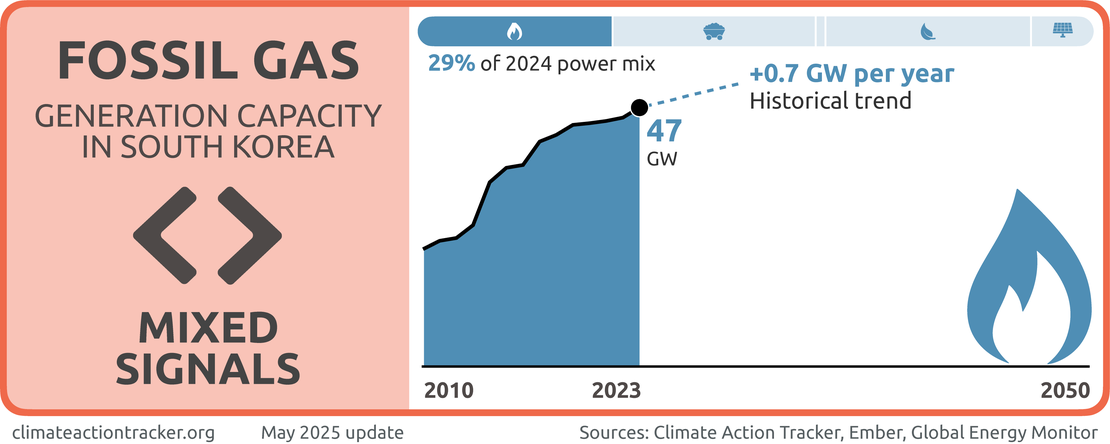
South Korea is also sending “Mixed signals” on fossil gas.
The share of fossil gas in South Korea’s electricity mix has remained stagnant in the last five years, with actual generation largely unchanged. However, the government is currently pursuing a coal-to-gas strategy that will significantly expand fossil gas capacity. In 2024 alone, 1.8 GW of new fossil gas capacity was installed, and a large pipeline of additional projects is currently under development (Ember, 2025; Global Energy Monitor, 2025).
The government aims for gas-fired power generation to make up 20.9% of South Korea’s power mix by 2030. This includes the plan to shut down 26 existing coal power plants (13.7 GW) and repurpose the sites for fossil gas-fired generation using imported LNG. Additionally, the government plans to build five new fossil gas plants, that are expected to add 4.3 GW of installed capacity. However, to remain on a pathway compatible to the Paris Agreement’s 1.5°C temperature limit, South Korea must phase out gas by 2035.
MOTIE also plans to produce hydrogen and ammonia power in their existing coal and LNG generators as part of their coal phase-out strategy. The government targeted commercialising at least 30% hydrogen co-firing by 2035 and a total burning by 2040. The government also plans to apply 20% ammonia co-firing power generation over more than half existing coal power plants (total 45 units) by 2030.
The ongoing fossil fuel investment and increasing fuel prices has led KEPCO (South Korean state-owned electricity provider; Korea Electric Power Corporation) to expose itself to financial risk. It is reported that KEPCO experienced operating losses of roughly USD5bn for the financial year ended 2021, USD 6bn and 5bn for Q1 and Q2 2022 respectively (IEEFA, 2022).
Renewables


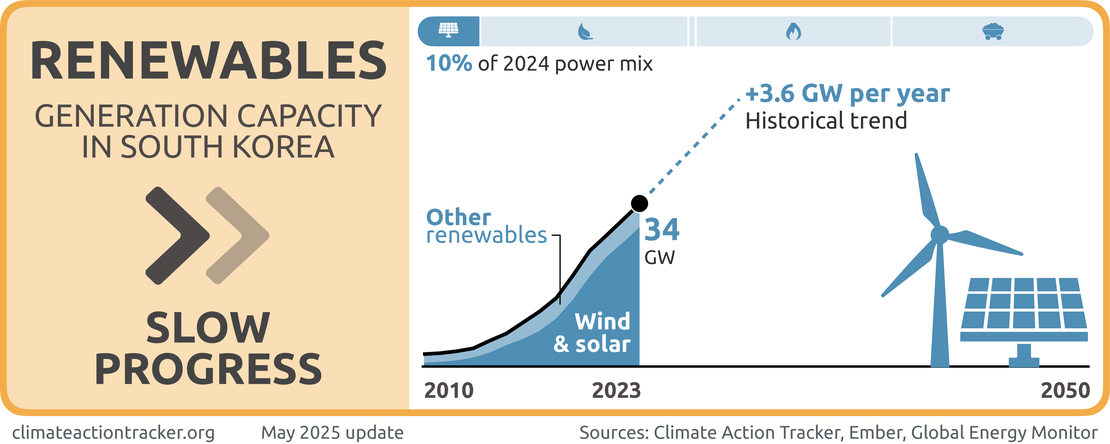
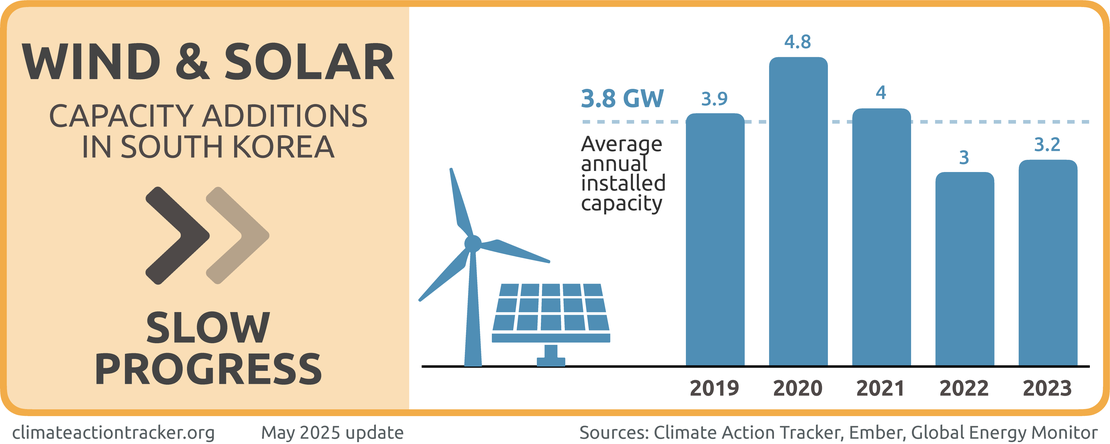
South Korea is making “Slow Progress” in deploying renewables.
The share of renewables in the power mix has gradually increased in the last five years, rising from 6% in 2019 to 10% in 2024. South Korea continues to expand its renewable capacity, adding an average of 3.8 GW of wind and solar to the grid each year over this period (Ember, 2025; Global Energy Monitor, 2025).
However, the outlook for future deployment remains uncertain, as President Yoon Suk-yeol decided to drop South Korea’s 100% renewables target, and reversed his predecessor’s denuclearisation policy (2017-2022), claiming that renewables are “too expensive”. However, there is no evidence to support that nuclear is cheaper than renewable energy (see section below).
Research from Climate Analytics suggests that an accelerated, Paris-compatible, coal-to-renewables transition could lead to almost a threefold increase in jobs when compared to the 2054 phase-out plan (Zimmer et al., 2021). In the scenario presented, job losses related to the coal phase-out would be outweighed by newly created jobs in the construction, installation, operation and maintenance of renewable energy and energy storage infrastructure, which amount to 63,000 additional jobs by 2025 and up to 92,000 in 2030.
The Renewable Portfolio Standard (RPS) replaced the feed-in tariff scheme in 2012 and is the main policy instrument to promote renewable energy. The RPS scheme requires major electricity utilities to increase their renewable and “new energy” share in the electricity mix to 10% by 2023 (Korea New and Renewable Energy Center, 2019). The revised Renewable Energy Act, passed in March 2021, raised the threshold to 25% by 2034. This law was effective from October 2021 and will support South Korea in achieving its renewable energy targets.
Recent studies suggest that South Korea can achieve carbon neutrality by 2050 through establishing an interim renewable target of at least 53% by 2030, to grow into 84% by 2050; and ensuring coal is phased out by 2035, and natural gas power plants by 2045 (GESI et al., 2022).
Nuclear energy
Expanding nuclear energy remains a pillar of South Korea’s decarbonisation strategy, accounting for 30% of power mix in 2024 (Ember, 2025). As mentioned above, President Yoon Suk-yeol reversed his predecessor’s denuclearisation policy (2017-2022), claiming that renewables are “too expensive”. However, there is no evidence to support that nuclear is cheaper than renewable energy. Nuclear power remains the most expensive form of energy to construct and deploy, despite having significantly lower system costs than intermittent renewables (World Nuclear Association, 2022).
According to a study using Levelised Cost of Energy (LCOE), solar and wind energy will cost around USD 40 per megawatt-hour, whereas nuclear will reach ca. USD175 per megawatt-hour (LAZARD, 2020). Due to high cost and lengthy construction process, increase in nuclear share is viewed as not strategic given the urgency of the climate issue (Reuters, 2019; Schneider M et al., 2019).
Under former President Moon’s government, the proportion of nuclear energy in the 2030 electricity mix declined from almost 30% to 26.5% (The Diplomat, 2022). In contrast, the new administration just released its “10th Basic Electricity Plan’, projecting the share of nuclear to increase to 32.8% (MOTIE, 2023). President Yoon and his administration committed KRW 1,000 billion (USD 725m) for growing the nuclear industry by 2025 (Schneider et al., 2022b).
Aiming to revitalise South Korea’s nuclear industry, MOTIE signed a Memorandum of Understanding (MoU) with Government-owned Korea Hydro & Nuclear Power (KHNP), Doosan Enerbility and nuclear energy equipment and materials manufacturers to further encourage the nuclear industry to achieve carbon neutrality and power security (MOTIE, 2022). MoE intended listing nuclear power in the K-taxonomy, also aligning its implementation to EU’s nuclear safety guidelines to attract green investment (Ministry of Environment, 2022a).
The focus on nuclear production endangers a fast transition for renewable energy in South Korea, Studies showed that it is feasible for South Korea to increase its renewable energy target from 20.8% in 2030 to more than 50% in 2030, particularly given a number of studies demonstrate that South Korea could achieve high shares of renewable energy, including reaching close to 100% by 2050 (Climate Analytics, 2020; C.-S. Hong, 2019; GESI et al, 2022).
Hydrogen
The roadmap for the hydrogen economy, published in January 2019 (MOTIE, 2019b) sets a goal of power generating capacity from fuel cells from 308 MW in 2018 to 15 GW by 2040. In 2020, South Korea introduced a hydrogen law (the Hydrogen Act) aiming to develop a hydrogen economy and expand public access to alternative fuel. South Korea’s hydrogen demand – at 13,000 t/year in 2019 – is produced from petrochemical industry by-products. Under the Hydrogen Roadmap, the demand will increase to 5.36 million t/year by 2040, and the additional demand in the short term will be met by LNG, so will not lead to significant emission reductions.
However, South Korea is investigating options for producing green hydrogen in the long term. In May 2022, South Korea created a Clean Hydrogen Portfolio Standard (CHPS), a mandatory renewable energy supply system using hydrogen under the Hydrogen Act (2020) by excluding hydrogen energy and fuel cells from the scope of the current RPS scheme. The Hydrogen Act sets out a grade-based certification system for clean hydrogen. It also requires operators of hydrogen fuel supply facilities to list a minimum percentage of clean hydrogen on the product. The government has announced its intention to establish a clean hydrogen supply chain and is competing to nurture a world-leading hydrogen industry (MOTIE, 2023).
Industry
The industry sector accounted for 7.5% of national CO2 emissions (Enerdata, 2022). The main policy regulating industrial emissions is the K-ETS (Korea’s Emissions Trading Scheme), which in Phase 3 (2021-2025) covers 73.5% of national GHG emissions and 685 companies in 69 subsectors, including main industries like steel, cement, and petrochemicals. Companies subject to the ETS are eligible for financial support from the government, which can be used to install energy-efficient equipment and processes.
In August 2022, the government had a Council meeting to discuss a revenue allocation plan and strategy to meet the EU’s Carbon Border Adjustment Mechanism (CBAM). Sets of new rules will be launched for Phase 4 by 2026 (ICAP, 2022b). The government has reported that the total revenue in 2021 was KRW 257.7 million, allocated as climate response fund (ICAP, 2022a).
The majority of existing energy efficiency measures in industry are voluntary, such as the Energy Champion programme, the Energy Intensity Reduction Agreement, and the Energy Management System (IEA, 2020). The main regulation for energy efficiency in industry is the Target Management System, which requires companies that emit over 50 ktCO2e (or 15 ktCO2e for individual businesses), to set a legally binding energy reduction target in consultation with the government.
In 2021, the Ministry of Trade, Industry and Energy launched the Green Steel Committee, which aims to align the domestic steel industry with South Korea’s climate neutrality target (Min-hee, 2021). At the launch, several major Korean steel manufacturers signed a joint statement for 2050 carbon neutrality, including POSCO, Hyundai Steel, Dongkuk Steel, KG Dongbu Steel, Seah Steel, and SIMPAC.
Transport
In 2019, the transport sector accounted for 18% of national CO2 emissions from fuel combustion (IEA, 2021a). The revised 2030 GHG roadmap intends to expand the supply of eco-friendly vehicles (including the supply of three million electric vehicles in 2030) (Ministry of Environment, 2018). In January 2019, the Korean Government also announced a roadmap for a hydrogen economy, setting goals of producing 6.2 million fuel cell electric vehicles and building 1,200 fuelling stations across the country by 2040 (MOTIE, 2019b).
The Green New Deal, announced in 2020, commits around USD 17bn to the development of eco-friendly vehicles and related infrastructure (Ministry of Economy and Finance, 2020). By 2025 the government plans to introduce 1.13 million electric cars, 200,000 hydrogen cars, and scrap 2.2 million old diesel cars. A Climate Neutrality Roadmap (GESI et al., 2022) scenario suggests that a rapid adoption of around 10 million climate-friendly vehicles in road transport would lead to drastic reduction by more than 40% (41 MtCO2e) between 2018 (98 MtCO2e) and 2030 (57 MtCO2e).
Announced through the carbon neutral green growth vison and promotion strategy, government planned to lay out energy consumption strategy in industry sector by Introducing electric vehicle efficiency rating system and fuel efficiency system for mid-to-large sized trucks (MOLIT, 2022).
South Korea is the world’s fifth largest car manufacturing country (OICA, 2019) and home to major companies such as Hyundai and Kia. In 2014, South Korea strengthened its light-duty vehicle emissions standard to 97 gCO2/km by 2020 (Transportpolicy.net, 2019), which is comparable to the EU’s new standards (95 gCO2/km) (ICCT, 2019).
In December 2020, the Ministry of Oceans and Fisheries announced the First National Plan for the Development and Popularisation of Green Ships (2021-2030), which aims to explore advanced emissions-free technologies and sets targets to reduce shipping emissions by 70% by 2030 and convert 15% Korean ships to “green ships” (Ministry of Oceans and Fisheries, 2021). Due to their technological advancement, South Korean shipbuilders won nearly 57% of global orders for eco-friendly ships in the first eight months of 2022 (Seanews, 2022).
Buildings
In 2019, the buildings sector accounted for 8% of national CO2 emissions from fuel combustion (aggregate of residential and commercial sectors) (IEA, 2021a). South Korea is gradually applying stricter energy conservation designs to meet zero-energy buildings standards for all new buildings by 2025 (APERC, 2019).
The revised 2030 GHG roadmap outlines several policies and measures for reducing emissions from the sector, including strengthening permit standards for new buildings, promoting green renovation, identifying new circular business models, and expanding renewable energy supply. The reduction target from buildings is 35.8 MTCO2e by 2030 below 2016 baseline.
In addition, the Green New Deal commits around USD 4.5 billion to green remodeling, which aims to ensure that new and renovated buildings are energy-efficient and constructed from sustainable materials (Ministry of Economy and Finance, 2020). By 2025 the Green New Deal plans to remodel 225,000 homes, 440 day-care centres, and 1,148 facilities. Also, through its Framework Act on Carbon Neutrality and Green Growth, South Korea intended to build a carbon neutral city in order to achieve carbon neutral spatially (Ministry of Environment, 2022b).
Further analysis
Latest publications
Stay informed
Subscribe to our newsletter
